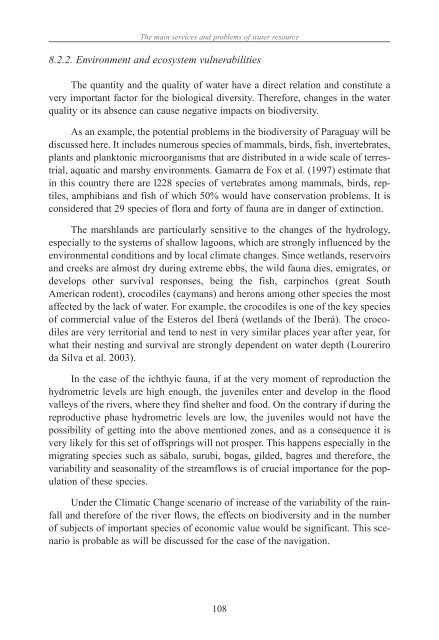chapter - Atmospheric and Oceanic Science
chapter - Atmospheric and Oceanic Science
chapter - Atmospheric and Oceanic Science
You also want an ePaper? Increase the reach of your titles
YUMPU automatically turns print PDFs into web optimized ePapers that Google loves.
The main services <strong>and</strong> problems of water resource<br />
8.2.2. Environment <strong>and</strong> ecosystem vulnerabilities<br />
The quantity <strong>and</strong> the quality of water have a direct relation <strong>and</strong> constitute a<br />
very important factor for the biological diversity. Therefore, changes in the water<br />
quality or its absence can cause negative impacts on biodiversity.<br />
As an example, the potential problems in the biodiversity of Paraguay will be<br />
discussed here. It includes numerous species of mammals, birds, fish, invertebrates,<br />
plants <strong>and</strong> planktonic microorganisms that are distributed in a wide scale of terrestrial,<br />
aquatic <strong>and</strong> marshy environments. Gamarra de Fox et al. (1997) estimate that<br />
in this country there are l228 species of vertebrates among mammals, birds, reptiles,<br />
amphibians <strong>and</strong> fish of which 50% would have conservation problems. It is<br />
considered that 29 species of flora <strong>and</strong> forty of fauna are in danger of extinction.<br />
The marshl<strong>and</strong>s are particularly sensitive to the changes of the hydrology,<br />
especially to the systems of shallow lagoons, which are strongly influenced by the<br />
environmental conditions <strong>and</strong> by local climate changes. Since wetl<strong>and</strong>s, reservoirs<br />
<strong>and</strong> creeks are almost dry during extreme ebbs, the wild fauna dies, emigrates, or<br />
develops other survival responses, being the fish, carpinchos (great South<br />
American rodent), crocodiles (caymans) <strong>and</strong> herons among other species the most<br />
affected by the lack of water. For example, the crocodiles is one of the key species<br />
of commercial value of the Esteros del Iberá (wetl<strong>and</strong>s of the Iberá). The crocodiles<br />
are very territorial <strong>and</strong> tend to nest in very similar places year after year, for<br />
what their nesting <strong>and</strong> survival are strongly dependent on water depth (Loureriro<br />
da Silva et al. 2003).<br />
In the case of the ichthyic fauna, if at the very moment of reproduction the<br />
hydrometric levels are high enough, the juveniles enter <strong>and</strong> develop in the flood<br />
valleys of the rivers, where they find shelter <strong>and</strong> food. On the contrary if during the<br />
reproductive phase hydrometric levels are low, the juveniles would not have the<br />
possibility of getting into the above mentioned zones, <strong>and</strong> as a consequence it is<br />
very likely for this set of offsprings will not prosper. This happens especially in the<br />
migrating species such as sábalo, surubi, bogas, gilded, bagres <strong>and</strong> therefore, the<br />
variability <strong>and</strong> seasonality of the streamflows is of crucial importance for the population<br />
of these species.<br />
Under the Climatic Change scenario of increase of the variability of the rainfall<br />
<strong>and</strong> therefore of the river flows, the effects on biodiversity <strong>and</strong> in the number<br />
of subjects of important species of economic value would be significant. This scenario<br />
is probable as will be discussed for the case of the navigation.<br />
108






